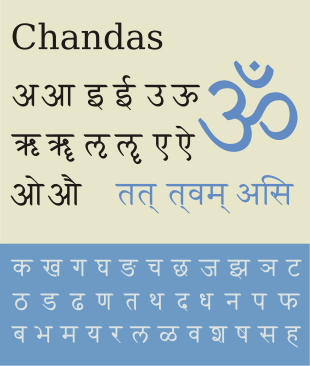දේවනාගරී
| දේවනාගරී देवनागरी | |
|---|---|
 චන්දස් ෆොනුරුව තුළ දේවනාගරී අක්ෂර (ස්වර ඉහළ, ව්යඤ්ජන පහළ) | |
| වර්ගය | |
| භාෂා | අපභ්රංශ, ආවධි, Bhili, භෝජ්පූරි, Bodo, බ්රාජ් භාෂා, ඡත්තීස්ගර්හි, Dogri, ගුජරාටි, Haryanvi, හින්දි, හින්දුස්තාන්, කාශ්මීරි, Konkani, මාගහී, මෛථිලි, මරාඨි, Marwari, Mundari, Newari, නේපාලි, පාලි, Pahari (විවිධ), ප්රාකෘත, රාජස්ථානි, Sadri, සංස්කෘත, Santali, Saraiki, Sherpa සහ සින්ධි, Surjapuri, සහ තවත් බොගෝ |
| කාල වකවානුව | මුල්කාලීන් ස්වරූපය: ක්රි.ව. 1වන සියවස පමණ[1] නූතන ස්වරූපය: ක්රි.ව. 7වන සියවසේ සිට වර්තමානය තෙක්[2][3] |
මාතෘ ක්රම | |
සහෝදර ක්රම | නන්දිනාගරී Kaithi ගුජරාටි මෝඩී |
| දිශානතිය | Left-to-right |
| ISO 15924 | Deva, 315 |
යුනිකේත අන්වර්ථ | Devanagari |
යුනිකේත පරාසය | U+0900–U+097F Devanagari, U+A8E0–U+A8FF Devanagari Extended, U+1CD0–U+1CFF Vedic Extensions |
[a] බ්රාහ්මී අක්ෂරවල සෙමිටික් ප්රභවය පිළිබඳ මතය සම්පූර්ණයෙන් පිළිගැනීමට ලක්ව නැත. | |
| දේවනාගරී |
|---|
 |
|
| බ්රාහ්මීය අක්ෂර මාලා |
|---|
| බ්රාහ්මී අක්ෂර මාලාව සහ ඉන් පැවතෙන්නන් |
දේවනාගරී (/ˌdeɪvəˈnɑːɡəri/ DAY-və-NAH-gər-ee; देवनागरी, IAST: Devanāgarī, සංස්කෘත උච්චාරණය: [deːʋɐˈnaːɡɐɽiː]), හෙවත් නාගරී (Nāgarī, नागरी),[6] යනුවෙන් හැඳින්වෙන්නේ වමේ සිට දකුණට ලියනු ලබන අබුගිඩා ලේඛන ක්රමයකි.[7] මෙය ඉන්දියානු උපමහාද්වීපයේ පුරාතන බ්රාහ්මී අක්ෂර ආශ්රයෙන් බිහිවූවකි.[1] මෙය පුරාතන ඉන්දියාවේ ක්රි.ව. 1වන සිට 4වන සියවස දක්වා කාලයේ වර්ධනය විය.[1] ක්රි.ව. 7වන සියවස වන විට එය සාමාන්ය භාවිතයේ පැවතිණි.[6][8] දේවනාගරී අක්ෂර මාලාව ස්වර අක්ෂර 14ක් සහ ව්යඤ්ජන අක්ෂර 33ක් ලෙස ප්රධාන අක්ෂර 47කින් සමන්විත ය. එය ලොව සිව්වෙනියට වඩාත්ම භාවිතා වන අක්ෂර ක්රමය වේ.[9] මෙය දැනට භාෂා 120කට අධික සංඛ්යාවක භාවිතා වේ.[10]
මේවාත් බලන්න
- ඉන්දියාවේ භාෂා
- දේවනාගරී ප්රතිලේඛනය
- දේවනාගරී බ්රේල්
- ISCII
- නාගරී ප්රචාරිණී සභා
- නයනාගරී
- නේපාලි
ආශ්රේයයන්
උද්ධෘත
- ↑ 1.0 1.1 1.2 Cite warning:
<ref>tag with namegazettcannot be previewed because it is defined outside the current section or not defined at all. - ↑ Isaac Taylor (1883), History of the Alphabet: Aryan Alphabets, Part 2, Kegan Paul, Trench & Co, p. 333, ISBN 978-0-7661-5847-4, https://archive.org/stream/alphabet00unkngoog#page/n348/mode/2up/, "... In the Kutila this develops into a short horizontal bar, which, in the Devanagari, becomes a continuous horizontal line ... three cardinal inscriptions of this epoch, namely, the Kutila or Bareli inscription of 992, the Chalukya or Kistna inscription of 945, and a Kawi inscription of 919 ... the Kutila inscription is of great importance in Indian epigraphy, not only from its precise date, but from its offering a definite early form of the standard Indian alphabet, the Devanagari ..."
- ↑ Salomon, Richard (1998). Indian epigraphy: a guide to the study of inscriptions in Sanskrit, Prakrit, and the other Indo-Aryan languages. South Asia research. Oxford: Oxford University Press. pp. 39–41. ISBN 978-0-19-509984-3.
- ↑ Daniels, P.T. (January 2008). "Writing systems of major and minor languages".
{cite journal}: Cite journal requires|journal=(help) - ↑ Masica, Colin (1993). The Indo-Aryan languages. p. 143.
- ↑ 6.0 6.1 Kathleen Kuiper (2010), The Culture of India, New York: The Rosen Publishing Group, ISBN 978-1615301492, page 83
- ↑ Cite warning:
<ref>tag with namegeorgeccannot be previewed because it is defined outside the current section or not defined at all. - ↑ Cite warning:
<ref>tag with namesalomon1000cannot be previewed because it is defined outside the current section or not defined at all. - ↑ David Templin. "Devanagari script". omniglot.com. සම්ප්රවේශය 5 April 2015.
- ↑ Devanagari (Nagari), Script Features and Description, SIL International (2013), United States
සැකිල්ල:Devanagari abugida
සැකිල්ල:Hindi topics
සැකිල්ල:Sanskrit language topics